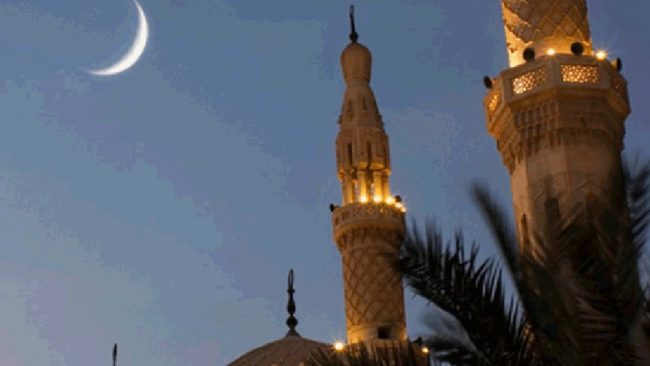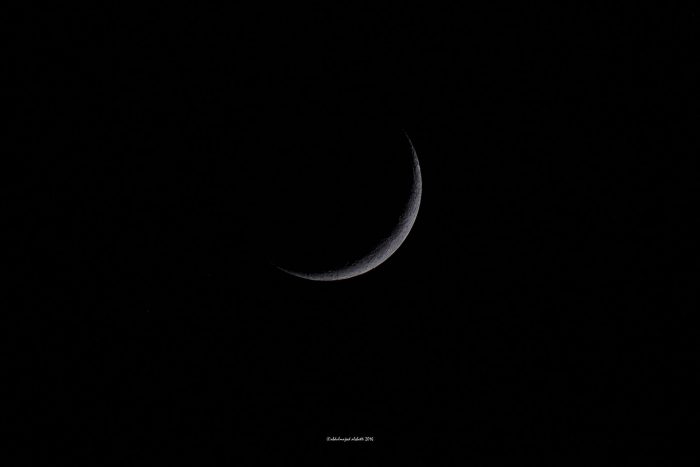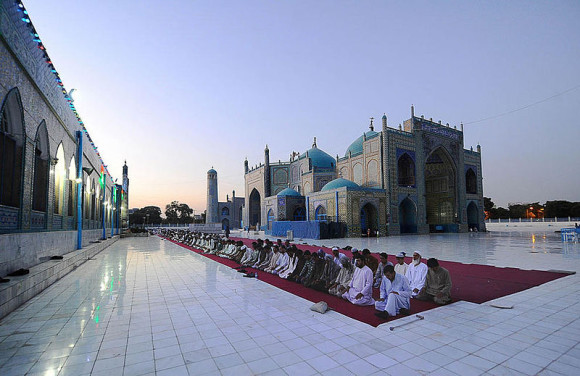

Traditionally, the first sighting of a young moon marks the beginning of Ramadan. Image via Emirates 24/7.
The Islamic holy month of Ramadan falls at a different time each year because the Islamic calendar is a lunar calendar, based on the moon’s natural cycles. That’s why there isn’t a fixed date for Ramadan, which is the 9th month in this calendar, traditionally determined by the sighting of a crescent moon. Today – May 15, 2018 – is the date of new moon, that is, a moon most directly between the Earth and sun for this month. New moon comes at 11:48 UTC today (12:48 p.m. London Time; 7:48 a.m. Eastern Daylight Time in the U.S; translate UTC to your time). We’ve seen some announcements that Ramadan in 2018 will begin this evening – the evening of May 15. We’ve seen other announcements that the beginning of Ramadan will be announced on May 15.
Will anyone on Earth be able to see the moon on this Tuesday evening with the eye alone? Yes. Possibly. Spring is the best time to see a very young moon (a moon visible in the west after sunset, in the hours or days after new moon). So the chances are best from Earth’s Northern Hemisphere, where it’s spring now. And chances are best for those for those living at longitudes farther and farther west from, say, London. The farther west you are, the more time will have passed on your clock since the instant of new moon. Thus, because the moon orbits Earth continuously, the moon will have had more time to move away from our line of sight to the sun, on the sky’s dome.
In other words, the farther west you are, the longer after sunset the moon will set. The darker your sky will be. For those reasons, the farther west you are from, say, London, on May 15, the more likely it is you’ll be to see the moon.
Let’s consider the youngest moon that can be seen with the eye alone. A young moon is a waxing crescent moon, seen in west just after sunset.
A longstanding, though somewhat doubtful, record for youngest moon seen with the eye was held by two British housemaids, said to have seen the moon 14-and-three-quarter hours after new moon, in the year 1916. That story has been around for over 100 years. Is it true? Who knows?
A more reliable record was achieved by well-known writer, photographer, and naturalist Stephen James O’Meara in May 1990. He saw a young crescent with the unaided eye 15 hours and 32 minutes after new moon. Stephen had amazing eyesight when he was younger; he saw a number of noteworthy astronomical sights. Click here to read more about the youngest moons it’s possible to see.
I haven’t heard of anyone besting Stephen’s record, so let’s assume 15 hours and 32 minutes is the record for the youngest moon.
Will it be possible to see a young moon after sunset on May 15 from, say, the Middle East? No. Let’s use Dubai in the United Arab Emirates as an example. Dubai is 4 hours ahead of UTC. New moon is 11:48 UTC on May 15; so new moon comes at 15:48 (3:48 p.m.) on Tuesday in Dubai. At sunset that evening (6:56 p.m.), as seen from Dubai, the moon will be only three hours old, invisible in the sun’s glare. And in fact, Dubai is one of the places where it’s been announced that the UAE’s moon-sighting committee will meet on May 15 to decide the start date of Ramadan.
How about London? No. At sunset on May 15, the moon will be a few hours older than it will be at sunset in Dubai, but not old enough to be visible to the eye after sunset.
Let’s keep going west. How about somewhere in North America? Consider Pacific Daylight Time, which is 7 hours behind UTC. New moon happens in, say, Los Angeles at 4:48 a.m. Pacific Daylight Time on Tuesday, May 15 (11:48 UTC – 7 = 4:48 a.m.). The sun sets in Los Angeles at 7:48 p.m. on May 15. Thus at sunset on May 15 – as seen from Los Angeles – the moon will be 15 hours old. Remember … 15 hours and 32 minutes is the record youngest moon. That record has been around since 1990. It’s doubtful it’ll be broken from the contiguous U.S. states on May 15 … but presumably it’s possible.
The best place to catch sight of the young moon on May 15 will be an island in the Pacific Ocean. Honolulu, Hawaii – for example – is 10 hours behind UTC. So new moon happens on May 15 at 1:48 a.m. for Honolulu. The sun sets in 7:03 p.m. on May 15. On that evening, after sunset, the moon will be about 17 hours old and definitely possible to see, though it’ll still be an extremely challenging observation. You’ll need a very clear sky after sunset, all the way to the western horizon. Binoculars will come in handy for finding the moon; once you spot it, try then taking the binoculars away and viewing the moon with the eye alone.
As you go west from Hawaii to the International Date Line, the potential for a young moon sighting on May 16 continues to get better. It get better still when you cross the International Date Line, into, say, Asia (again, we’re staying in the Northern Hemisphere, because the young moon is easier to see from this hemisphere at this time of year than it is from the Southern Hemisphere). From much of Asia on May 16, the young moon will be possible to see.
And – as Earth spins under the sky, and the moon moves in orbit, putting distance between itself and our line of sight to the sun – the moon will get easier and easier to see. It should most definitely be possible to see the moon from, say, India or the Middle East on May 16, assuming you have excellent sky conditions.

This young moon – June, 2016 – marked a beginning of Ramadan. Abdulmajeed Alshatti took this photo from Kuwait.
Ramadan, for observant Muslims, is a time of fasting, prayer and charitable giving.
Here is a beautiful poem about Ramadan, by Rumi, a 13th-century Persian poet and mystic:
O moon-faced Beloved,
the month of Ramadan has arrived
Cover the table
and open the path of praise.
O fickle busybody,
it’s time to change your ways.
Can you see the one who’s selling the halvah
how long will it be the halvah you desire?
Just a glimpse of the halvah-maker
has made you so sweet even honey says,
“I’ll put myself beneath your feet, like soil;
I’ll worship at your shrine.”
Your chick frets within the egg
with all your eating and choking.
Break out of your shell that your wings may grow.
Let yourself fly.
The lips of the Master are parched
from calling the Beloved.
The sound of your call resounds
through the horn of your empty belly.
Let nothing be inside of you.
Be empty: give your lips to the lips of the reed.
When like a reed you fill with His breath,
then you’ll taste sweetness.
Sweetness is hidden in the Breath
that fills the reed.
Be like Mary – by that sweet breath
a child grew within her.
– Rumi

Men praying during Ramadan – a time of fasting, prayer and charitable giving – at the Blue Mosque in Mazar-i-Sharif, Afghanistan.
Bottom line: The Islamic holy month begins with the sighting of a young crescent moon. Some on islands in the Pacific might see the moon on May 15, 2018, but most will see it on May 16 or even May 17.
from EarthSky https://ift.tt/2KpWt9W


Traditionally, the first sighting of a young moon marks the beginning of Ramadan. Image via Emirates 24/7.
The Islamic holy month of Ramadan falls at a different time each year because the Islamic calendar is a lunar calendar, based on the moon’s natural cycles. That’s why there isn’t a fixed date for Ramadan, which is the 9th month in this calendar, traditionally determined by the sighting of a crescent moon. Today – May 15, 2018 – is the date of new moon, that is, a moon most directly between the Earth and sun for this month. New moon comes at 11:48 UTC today (12:48 p.m. London Time; 7:48 a.m. Eastern Daylight Time in the U.S; translate UTC to your time). We’ve seen some announcements that Ramadan in 2018 will begin this evening – the evening of May 15. We’ve seen other announcements that the beginning of Ramadan will be announced on May 15.
Will anyone on Earth be able to see the moon on this Tuesday evening with the eye alone? Yes. Possibly. Spring is the best time to see a very young moon (a moon visible in the west after sunset, in the hours or days after new moon). So the chances are best from Earth’s Northern Hemisphere, where it’s spring now. And chances are best for those for those living at longitudes farther and farther west from, say, London. The farther west you are, the more time will have passed on your clock since the instant of new moon. Thus, because the moon orbits Earth continuously, the moon will have had more time to move away from our line of sight to the sun, on the sky’s dome.
In other words, the farther west you are, the longer after sunset the moon will set. The darker your sky will be. For those reasons, the farther west you are from, say, London, on May 15, the more likely it is you’ll be to see the moon.
Let’s consider the youngest moon that can be seen with the eye alone. A young moon is a waxing crescent moon, seen in west just after sunset.
A longstanding, though somewhat doubtful, record for youngest moon seen with the eye was held by two British housemaids, said to have seen the moon 14-and-three-quarter hours after new moon, in the year 1916. That story has been around for over 100 years. Is it true? Who knows?
A more reliable record was achieved by well-known writer, photographer, and naturalist Stephen James O’Meara in May 1990. He saw a young crescent with the unaided eye 15 hours and 32 minutes after new moon. Stephen had amazing eyesight when he was younger; he saw a number of noteworthy astronomical sights. Click here to read more about the youngest moons it’s possible to see.
I haven’t heard of anyone besting Stephen’s record, so let’s assume 15 hours and 32 minutes is the record for the youngest moon.
Will it be possible to see a young moon after sunset on May 15 from, say, the Middle East? No. Let’s use Dubai in the United Arab Emirates as an example. Dubai is 4 hours ahead of UTC. New moon is 11:48 UTC on May 15; so new moon comes at 15:48 (3:48 p.m.) on Tuesday in Dubai. At sunset that evening (6:56 p.m.), as seen from Dubai, the moon will be only three hours old, invisible in the sun’s glare. And in fact, Dubai is one of the places where it’s been announced that the UAE’s moon-sighting committee will meet on May 15 to decide the start date of Ramadan.
How about London? No. At sunset on May 15, the moon will be a few hours older than it will be at sunset in Dubai, but not old enough to be visible to the eye after sunset.
Let’s keep going west. How about somewhere in North America? Consider Pacific Daylight Time, which is 7 hours behind UTC. New moon happens in, say, Los Angeles at 4:48 a.m. Pacific Daylight Time on Tuesday, May 15 (11:48 UTC – 7 = 4:48 a.m.). The sun sets in Los Angeles at 7:48 p.m. on May 15. Thus at sunset on May 15 – as seen from Los Angeles – the moon will be 15 hours old. Remember … 15 hours and 32 minutes is the record youngest moon. That record has been around since 1990. It’s doubtful it’ll be broken from the contiguous U.S. states on May 15 … but presumably it’s possible.
The best place to catch sight of the young moon on May 15 will be an island in the Pacific Ocean. Honolulu, Hawaii – for example – is 10 hours behind UTC. So new moon happens on May 15 at 1:48 a.m. for Honolulu. The sun sets in 7:03 p.m. on May 15. On that evening, after sunset, the moon will be about 17 hours old and definitely possible to see, though it’ll still be an extremely challenging observation. You’ll need a very clear sky after sunset, all the way to the western horizon. Binoculars will come in handy for finding the moon; once you spot it, try then taking the binoculars away and viewing the moon with the eye alone.
As you go west from Hawaii to the International Date Line, the potential for a young moon sighting on May 16 continues to get better. It get better still when you cross the International Date Line, into, say, Asia (again, we’re staying in the Northern Hemisphere, because the young moon is easier to see from this hemisphere at this time of year than it is from the Southern Hemisphere). From much of Asia on May 16, the young moon will be possible to see.
And – as Earth spins under the sky, and the moon moves in orbit, putting distance between itself and our line of sight to the sun – the moon will get easier and easier to see. It should most definitely be possible to see the moon from, say, India or the Middle East on May 16, assuming you have excellent sky conditions.

This young moon – June, 2016 – marked a beginning of Ramadan. Abdulmajeed Alshatti took this photo from Kuwait.
Ramadan, for observant Muslims, is a time of fasting, prayer and charitable giving.
Here is a beautiful poem about Ramadan, by Rumi, a 13th-century Persian poet and mystic:
O moon-faced Beloved,
the month of Ramadan has arrived
Cover the table
and open the path of praise.
O fickle busybody,
it’s time to change your ways.
Can you see the one who’s selling the halvah
how long will it be the halvah you desire?
Just a glimpse of the halvah-maker
has made you so sweet even honey says,
“I’ll put myself beneath your feet, like soil;
I’ll worship at your shrine.”
Your chick frets within the egg
with all your eating and choking.
Break out of your shell that your wings may grow.
Let yourself fly.
The lips of the Master are parched
from calling the Beloved.
The sound of your call resounds
through the horn of your empty belly.
Let nothing be inside of you.
Be empty: give your lips to the lips of the reed.
When like a reed you fill with His breath,
then you’ll taste sweetness.
Sweetness is hidden in the Breath
that fills the reed.
Be like Mary – by that sweet breath
a child grew within her.
– Rumi

Men praying during Ramadan – a time of fasting, prayer and charitable giving – at the Blue Mosque in Mazar-i-Sharif, Afghanistan.
Bottom line: The Islamic holy month begins with the sighting of a young crescent moon. Some on islands in the Pacific might see the moon on May 15, 2018, but most will see it on May 16 or even May 17.
from EarthSky https://ift.tt/2KpWt9W

Aucun commentaire:
Enregistrer un commentaire